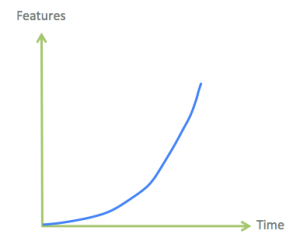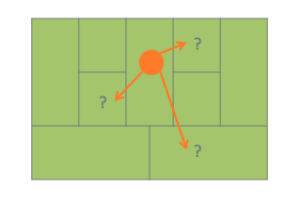It seems to be some kind of natural law that leads to an exponential feature growth on websites over time.
This exponential curve is mainly driven by budget planning circles regularly emphasizing the need to create hockey-stick-like revenue streams. But even without any revenue pressure, product managers are creative enough and want to be “productive” – too often backed up by a management that evaluates them based on the quantitative output of “innovative” stuff and the output of productivity being features, not knowledge.
Often all people involved are aware that too many features are being developed, however, nobody is capable of stopping the hamster wheel. What is missing is a structure that facilitates sound decisions whether an additional feature makes sense – or not.
In order to come up with such a decision structure, it is helpful to look back to the early days of companies. Every successful enterprise has gone (intentionally or not) through the following phases / questions:
- Vision: Why is the company existent?
- Product/Solution Fit: Do users perceive the vision’s concrete product as a good way to solve a real need?
- Product/Market Fit: Are there enough users out there that can be triggered with a repeatable process to buy the product and does this sum up to a reasonable business model?
- Scaling: Transfer of the learning curve from 1-3 into a long-term, profitable enterprise structure.
The result of these iterative steps 1-4 is a canvas (for the following it does not matter whether you prefer to use Alexander Osterwalders Business Model Canvas or Ash Maurya’s adoption Lean Canvas) with all quadrants being validated (=green), thus forming a working holistic business model:
The path to a working canvas is long and exhausting. Even WhatsApp took several years for this. And every “green” canvas is a fragile object by nature that only works in a specific context and a specific time. So, such a model requires a regular critical check-up and adjustments to changing internal and external conditions.
The trick for answering the initial question about the “right” features is to consider every new feature as potential threat and opportunity for the overall model at the same time. A change in one quadrant can jeopardize the whole model or lift it to the next level. The deeper the potential impact of a new function, the further back to the start you need to go and check whether it is really worthwhile to introduce it. So, the crucial questions for this are: Does this feature improve or break the …
- … Vision?
- … Product/Solution Fit?
- … Product/Market Fit?
- … Existing scaling mechanism?
Only very few companies ask these questions and it might look a bit artificial and overdone at first. But those who are not able to answer these questions quickly should know right upfront that they need to be careful. Over time this additional step will become a natural part of every feature discussion, so that decisions will be taken much more consciously in order to continuously sharpen the existing model rather than to dilute it. Building successful products sometimes means to be boring and to do few things well and right instead of chasing short-term KPIs and revenue targets with an ever increasing number of fancy features.
Photo by Bill Stillwell on flickr under CC License




